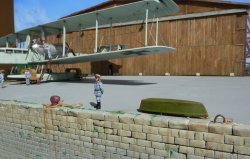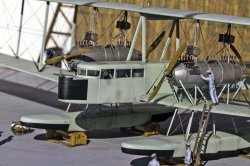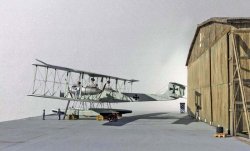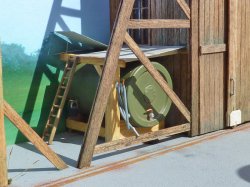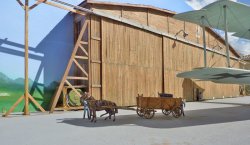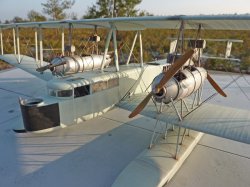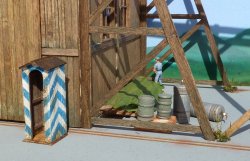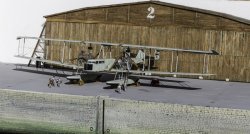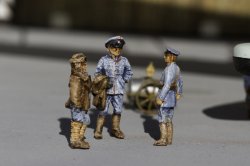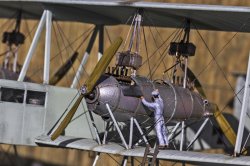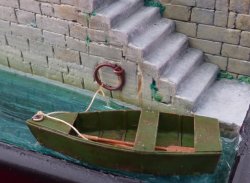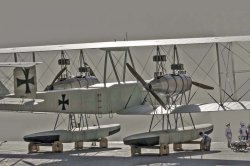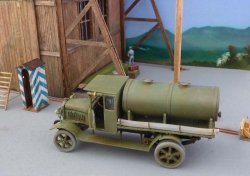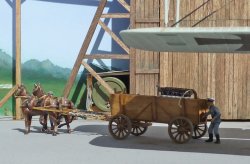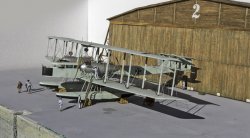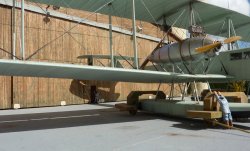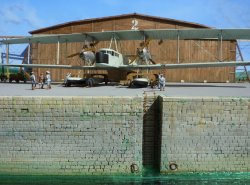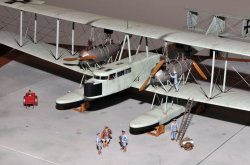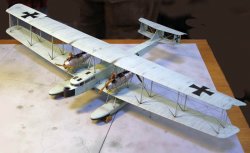
Galerie * Gallery - Staaken
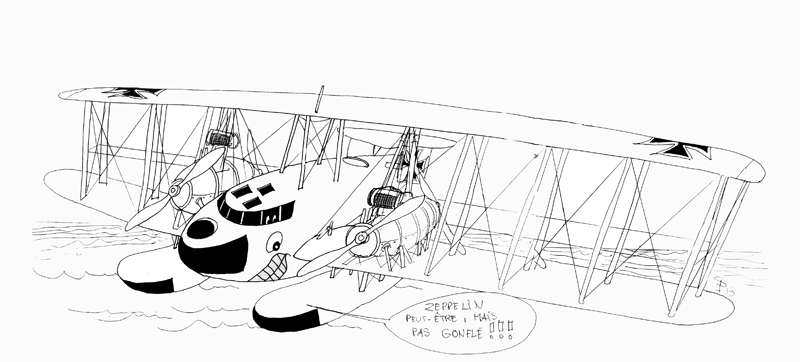
La raison de l'importance accrue accordée aux hydravions était que des avions anglais avaient très bien réussi à attaquer des dirigeables allemands. Cela a abouti à un ordre permanent que les dirigeables étaient restés supérieurs à 13.000 pieds, ce qui empêche leur utilisation comme sous-marin de faible niveau, le port et physionomistes mine. Prenant cela en compte, l'Amiral Philipp a recommandé l'élaboration et l'évaluation des moins-R vulnérables hydravions de l'hydravion et par catégorie hydravion. Dès Décembre 1916, l’Amiral Philipp a énuméré les avantages des avions par rapport aux dirigeables, comme suit : ils pouvaient voler plus vite, porter un plus grand armement défensif, ne nécessitent pas d'énormes hangars, pourrait être préparé pour le vol dans une fraction du temps, utilisé moins de personnel et étaient moins chers à construire...
Le 26 Décembre 1916, un rapport de Oberlt.zSMans, qui venait de rentrer d'une inspection de la R Dornier-flying-boat, et avec la remarque que Luftschiffbau Zeppelin est de présenter une nouvelle proposition pour satisfaire aux prescriptions ci-dessus de reconnaissance. Il convient de noter que, pendant la guerre, seules deux entreprises, Staaken et Dornier, toutes deux faisant parti du groupe Zeppelin, livré R-hydravions de la marine...
Staaken a proposé une version hydravion du Staaken R.VI, désigné Staaken L, qui a été commandé par la marine allemande le 15 Février 1917. Après avoir terminé en août 1917, le Staaken L, équipé d'un standard R.VI. châssis mobile, a été transporté vers le site d'hydravions de la compagnie d’essais à Potsdam, où les flotteurs étaient montés. Le 5 Septembre 1917, il a été lancé pour la première fois et a rapidement fait deux vols de courte durée. Les modifications apportées au cours des essais en vol comprenaient le remplacement des étroites hélices à quatre pales par des hélices standards à deux pales, en ajoutant un aileron central pour améliorer la stabilité directionnelle et le renforcement de la structure des jambes de force des flotteurs. Le 12 Novembre 1917, le Staaken L décolle de Potsdam pour un vol de livraison mais en raison de la défaillance d'un moteur, a été forcé d'atterrir à Saaler Bodden, à quelque 40 km à l'est de Warnemünde. Après les réparations faites, le Staaken L était livré à la Marine le 14 Novembre 1917...
Un hangar en bois a été conçu et construit par Firma Carl Tuchscherer en 1917 à la maison du Staaken L. Construit au-dessus sur pilotis, le hangar était unique et la porte était seulement de 27,5 mètres de large. Une grande porte capable de résister aux vents élevés et EIG aurait été difficile à installer et à entretenir. Par conséquent, pour garder la petite porte, il a été décidé de mettre l'avion dans le hangar de côté, en utilisant une nouvelle technique. Des expériences ont prouvé l'impossibilité de mettre un avion dans un hangar sur le côté, même dans les moindres conditions de vent et des vagues. Par conséquent, Tuchscherer a proposé et construit un pivot, une jetée flottante s'étendant en angle droit d'un côté de l'ouverture du hangar. Flotteur gauche de l'avion a été garanti à la jetée flottante. Ensuite, la jetée a été balancée autour, son extrémité côté pivot tournant l'appareil sur le côté cru de l'ouverture dans le hangar, comme elle a conclu un arc de 180 degrés. Les fermes du hangar étaient capables de supporter une charge de 12,000 kg, permettant la L Staaken être levées pour des réparations aux flotteurs. Un second, beaucoup plus vaste hangar capable d'abriter quatre centres de R-avions était en cours de construction à la fin de la guerre...
Le Staaken L s'est écrasé à Warnemünde, le 3 Juin 1918, tuant le pilote, le lieutenant-Haller et l'équipage. On sait très peu sur les résultats des tests d'évaluation du Staaken L. Il n'était pas aussi stable sur l'eau comme l’hydravion Dornier R. Les pointes des ailes allaient toucher l'eau à un talon 7 degrés, alors que l’hydravion avait besoin d'un talon 14 degrés. Néanmoins, on a une conception éprouvée que Staaken devait être construit en quantité, et il pourrait être produit en moins de temps que l’hydravion Dornier en métal. Six autres hydravions Staaken L ont été commandés par la marine...
Spécifications. Constructeur : Flugzeugwerft G; mbH, Staaken, Berlin. Moteurs :Quatre 260 H.P. Mercedes D IVa. Normal 0 21 MicrosoftInternetExplorer4 Envergure, 42,2 m.Longueur, 22,2 m. Hauteur, 7,38 m. Diamètre d'hélice, 4,4 m. Vitesse maximale, 125 km / h.Plafond, 2500 m...
The German navy's interest in seaplanes did not wane with the destruction of its RML.1s; on the contrary, naval authorities actively pursued the development of seaplanes for use in naval warfare...
The reason for the increased emphasis on seaplanes was that British aircraft had been very successful in attacking German airships. This led to a standing order that airships should remain above 13,000 feet, which precluded their use as low-level submarines, harbor and mine physionomists. Taking this into account, Admiral Philipp recommended the development and evaluation of vulnerable minus-R seaplanes and by seaplane category. As early as December 1916, Admiral Philipp listed the advantages of airplanes over airships, as follows: they could fly faster, carry greater defensive armament, did not require huge hangars, could be prepared for flight in a fraction of the time, used fewer personnel and were cheaper to build...
On December 26, 1916, a report from Oberlt.zSMans, who had just returned from an inspection of the R Dornier-flying-boat, and with the remark that Luftschiffbau Zeppelin is to submit a new proposal to meet the above reconnaissance requirements. It should be noted that, during the war, only two companies, Staaken and Dornier, both part of the Zeppelin group, delivered R-flying-boats to the navy...
Staaken proposed a seaplane version of the Staaken R.VI, designated Staaken L, which was ordered by the German navy on February 15, 1917. After completion in August 1917, the Staaken L, fitted with a standard R.VI. mobile chassis, was transported to the test company's seaplane site in Potsdam, where the floats were fitted. On September 5, 1917, it was launched for the first time and promptly made two short flights. Modifications made during flight tests included replacing the narrow four-blade propellers with standard two-blade ones, adding a central fin to improve directional stability, and reinforcing the float strut structure. On November 12, 1917, the Staaken L took off from Potsdam for a delivery flight but, due to engine failure, was forced to land at Saaler Bodden, some 40 km east of Warnemünde. After repairs, the Staaken L was delivered to the Navy on November 14, 1917...
A wooden shed was designed and built by Firma Carl Tuchscherer in 1917 at the Staaken L house. Built above on stilts, the shed was unique and the door was only 27.5 meters wide. A large door capable of withstanding high winds and EIG would have been difficult to install and maintain. So, to keep the door small, it was decided to put the plane in the hangar sideways, using a new technique. Experiments had shown that it was impossible to place a plane in a hangar on its side, even in the slightest wind and wave conditions. Consequently, Tuchscherer proposed and built a pivot, a floating jetty extending at right angles to one side of the hangar opening. The aircraft's left float was secured to the floating jetty. Next, the jetty was swung around, its pivot-side end turning the aircraft onto the raw side of the hangar opening, as it concluded a 180-degree arc. The hangar trusses were capable of supporting a load of 12,000 kg, allowing the L Staaken to be lifted for repairs to the floats. A second, much larger hangar capable of housing four R-avion centers was under construction at the end of the war...
The Staaken L crashed at Warnemünde on June 3, 1918, killing the pilot, Lieutenant Haller and crew. Very little is known about the results of the Staaken L's evaluation tests. It was not as stable on the water as the Dornier R seaplane. The wingtips would touch the water at a 7-degree heel, whereas the seaplane needed a 14-degree heel. Nevertheless, it was a proven concept that Staaken had to be built in quantity, and could be produced in less time than the metal Dornier seaplane. Six more Staaken L seaplanes were ordered by the navy...
Specifications. Manufacturer: Flugzeugwerft G; mbH, Staaken, Berlin. Engines: Four 260 H.P. Mercedes D IVa. Normal 0 21 MicrosoftInternetExplorer4 Wingspan, 42.2 m. Length, 22.2 m. Height, 7.38 m. Propeller diameter, 4.4 m. Maximum speed, 125 km/h. Ceiling, 2500 m...















